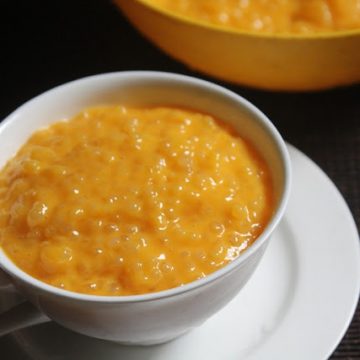Mango Sago Recipe (Mango Sago)
Mango Sago Recipe, is a creamy and refreshing dessert made with chewy sago pearls (sabudana), sweet mangoes, and rich condensed milk, often served chilled. Popular across many Asian cuisines and especially loved during mango season, this dessert strikes the perfect balance between fruity sweetness and velvety texture. Whether offered as prasadham or served as a light dessert after meals, Mango Sago feels like a bowl of sunshine — soothing, nostalgic, and soulfully delicious.
Print
Pin
Servings: 4 servings
Calories: 422kcal
Equipment
- Cooking pot
- Strainer
Ingredients
- ½ cup Sago / Sabudana / Javvarisi
- 3 cups Water
- 2 cups Mango Pulp
- 1 cup Sweetened Condensed Milk
Instructions
- Pre-Prep: Start by rinsing the sago lightly and keeping it aside. You don’t have to soak them, but doing so for 10–15 minutes can help cook them more evenly. Also, if using fresh mangoes, peel, chop, and puree them now.
- Cooking the Sago: Boil 3 cups of water in a large pan. Once boiling, add the sago pearls and cook them on medium flame until they become translucent. Stir occasionally to prevent sticking. This should take about 10–12 minutes. Once done, strain the sago and rinse under cold water to remove excess starch and stop further cooking.
- Making the Mango Sauce: In a mixing bowl, combine 2 cups of mango pulp and 1 cup of condensed milk. Whisk until smooth and creamy. If your mango pulp is a bit thick, feel free to thin it down with a tablespoon or two of milk or water.
- Combining Everything: Add the cooled, drained sago pearls to the mango-condensed milk mixture. Stir gently to combine everything. Taste and adjust sweetness if needed.
- Chilling: Transfer the mixture into serving bowls or a large container and refrigerate it for at least 2–4 hours. This helps the flavors come together and gives that chilled texture.
Video
Notes
Don’t overcook the sago: Watch closely while boiling — as soon as most pearls turn translucent with just a tiny white dot in the center, it’s time to stop. Overcooked sago turns mushy and loses its chewy charm.
Choose the right mangoes: If you’re making your own pulp, go for mangoes that are naturally sweet and non-fibrous — Alphonso and Banganapalli are excellent choices for their bright color and intense flavor.
Storage & Serving
Store your mango sago in an airtight container and refrigerate. It stays fresh for up to 2–3 days. Just give it a quick stir before serving as the sago might settle a bit. Serve it cold, preferably in small dessert bowls or fancy glasses. For that extra wow factor, top it off with fresh mango cubes, mint leaves for a refreshing touch, crushed pistachios or roasted cashews for a nutty crunch and you can even drizzle a little coconut milk or saffron-infused milk just before serving!Nutrition
Serving: 1servings | Calories: 422kcal | Carbohydrates: 84g | Protein: 7g | Fat: 7g | Saturated Fat: 4g | Polyunsaturated Fat: 0.3g | Monounsaturated Fat: 2g | Cholesterol: 26mg | Sodium: 159mg | Potassium: 284mg | Fiber: 2g | Sugar: 66g | Vitamin A: 3036IU | Vitamin C: 19mg | Calcium: 234mg | Iron: 15mg
Tried this recipe?Mention @yummytummyaarthi or tag #yummytummyaarthi!
Join us on FacebookFollow us on Facebook
Share by Email
Share on Facebook
